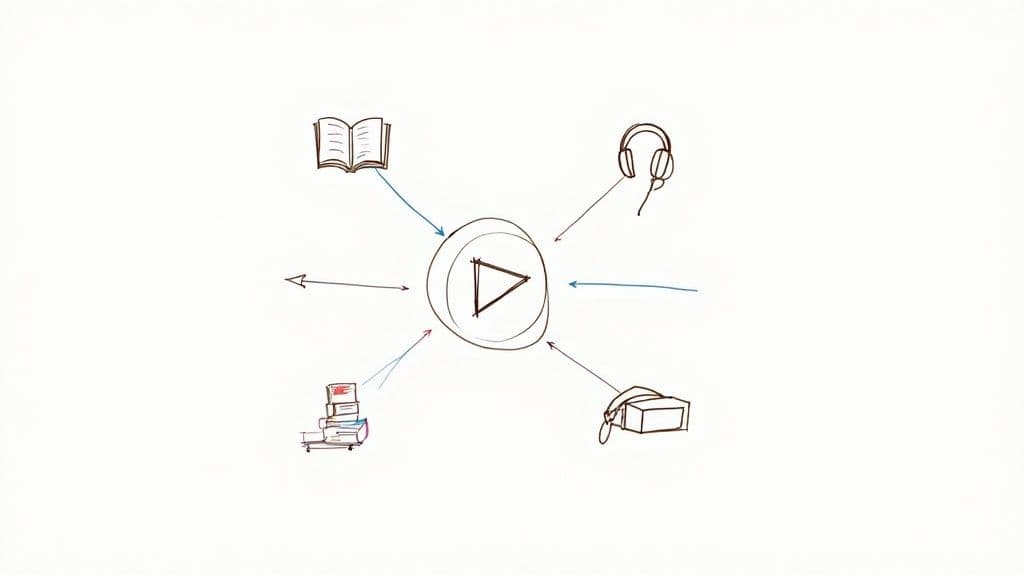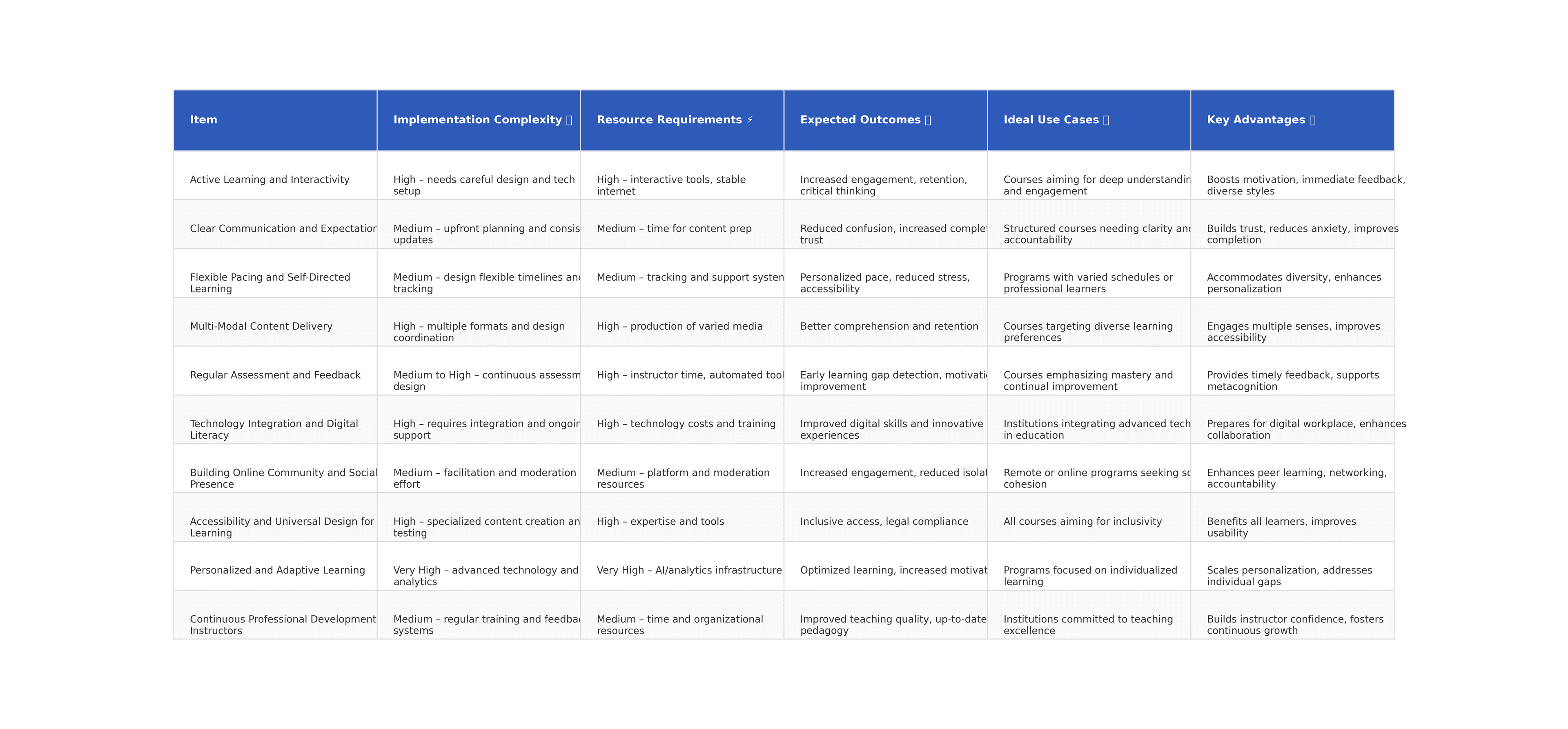Tutorial
Top Best Practices for Online Learning in 2025
Online learning has revolutionized education, offering unprecedented flexibility and access to knowledge. However, navigating this digital classroom requires more than just a stable internet connection and a webcam. True success hinges on adopting specific, proven strategies that foster genuine engagement, self-discipline, and deep comprehension. Too often, learners and instructors fall into a passive routine, leading to disconnection and diminished outcomes. Moving beyond the obvious "find a quiet space" advice is critical for anyone serious about making their educational investment count.
This guide provides a comprehensive roundup of the 10 best practices for online learning, curated to help students, educators, and lifelong learners thrive in any virtual setting. We bypass generic tips to deliver actionable insights, practical implementation details, and real-world examples that transform the digital learning experience. Forget passive viewing; the goal is to create an active, rewarding educational journey.
Inside, you will discover how to cultivate a structured yet adaptable learning schedule, effectively leverage technology for deeper interaction, and build a strong sense of community, even from thousands of miles away. Each point is designed to be immediately applicable, whether you are designing a course or trying to earn your next credential. These principles are the framework for not just completing a course, but truly mastering the material. Let's explore the essential techniques that define high-quality online education and set you up for success.
1. Active Learning and Interactivity
One of the most effective best practices for online learning is shifting from passive content consumption to active participation. Active learning transforms the digital classroom by requiring students to engage directly with the material through hands-on activities, problem-solving, and collaborative tasks. Instead of simply watching a lecture or reading text, learners become co-creators of their educational experience, which significantly boosts retention and deepens comprehension.

This approach is grounded in principles like Richard Mayer's Cognitive Load Theory, which suggests that meaningful learning occurs when students actively process information. Successful implementations are widespread, from Harvard Business School's renowned case-based discussion forums to MIT's use of intricate virtual labs that allow engineering students to conduct experiments remotely.
How to Implement Active Learning
To integrate this strategy effectively, you don't need to overhaul your entire learning process overnight. Start small and build momentum.
* Follow the 10-Minute Rule: Break up passive content by introducing a short interactive element, like a poll or a quick-response question, every 10 minutes.
* Use Diverse Tools: Incorporate varied activities such as interactive quizzes on platforms like Kahoot!, collaborative whiteboards for brainstorming, or peer-reviewed assignments on platforms like Coursera.
* Provide Clear Instructions: Ensure every interactive task has a clear objective and straightforward instructions to prevent confusion and maximize engagement.
* Facilitate Reflection: After an interactive session, guide learners through a reflection period. Ask what they learned, what challenged them, and how they can apply the knowledge. This step solidifies the learning experience.
By actively involving learners, you move them beyond memorization toward critical thinking and practical application. This method is particularly crucial for complex subjects that require more than just theoretical knowledge, making it a cornerstone of successful digital education.
2. Clear Communication and Expectations
One of the most foundational best practices for online learning is establishing transparent communication channels and explicit expectations from the outset. A well-structured digital learning environment depends on clarity, ensuring students know precisely what is required of them, how to succeed, and where to find help. Without this foundation, learners can feel isolated and confused, leading to disengagement and poor outcomes.

This principle is heavily promoted by organizations like the Online Learning Consortium (OLC) and Quality Matters, which set standards for high-quality online course design. Successful implementations include Arizona State University's comprehensive online orientations that set the stage for success and Penn State World Campus's detailed communication guidelines that foster a predictable and supportive academic environment.
How to Implement Clear Communication
Building a framework of clarity doesn't require complex tools, just intentional planning and consistency.
* Create a Welcome Video: Start the course with a short video explaining the overall structure, key deadlines, communication protocols, and your teaching philosophy. This personal touch builds immediate rapport.
* Establish 'Netiquette' Guidelines: Clearly define the rules for respectful and productive online interactions in forums, emails, and group projects to create a positive learning community.
* Use Consistent Organization: Structure all materials, from syllabi to weekly modules, with a consistent format. Use predictable naming conventions and layouts so students can navigate the course intuitively.
* Send Weekly Updates: Dispatch a regular announcement or email that summarizes the previous week's activities, outlines the upcoming week's tasks and deadlines, and offers timely encouragement or tips.
By proactively addressing potential points of confusion, you create a learning environment where students can focus their energy on mastering the material rather than deciphering logistics. This approach is essential for any online course, as it builds the trust and predictability necessary for students to thrive independently.
3. Flexible Pacing and Self-Directed Learning
One of the most essential best practices for online learning is embracing flexible pacing and self-directed learning. This approach empowers students to progress through course materials at a speed that aligns with their individual needs, schedules, and comprehension levels. Instead of a rigid, one-size-fits-all timeline, learners can take control of their educational journey, which fosters deeper engagement, reduces stress, and improves accessibility for those with diverse commitments.

This student-centric model has been successfully popularized by institutions like Western Governors University, which champions competency-based education, and platforms such as Udacity and Coursera, where flexible deadlines are a core feature of their Nanodegree and Specialization programs. The goal is to shift focus from time spent in a seat to the actual mastery of concepts, recognizing that genuine understanding happens at different rates for everyone.
How to Implement Flexible Pacing
Successfully adopting a self-directed model requires structure to prevent procrastination and ensure learners stay on track. Balance is key.
* Provide Pacing Guides: Offer a recommended schedule or pacing guide that outlines a clear path to completion. This provides structure for those who need it while still allowing for flexibility.
* Establish Progress Milestones: Set regular, low-stakes check-ins or milestones, such as quizzes or short assignments, to help students gauge their progress and maintain momentum.
* Offer Optional Synchronous Support: Host optional live sessions, like office hours or Q&A forums, to provide real-time support without mandating attendance. You can also explore various AI study hacks for college students that support self-paced learning.
* Foster Peer Accountability: Create opportunities for learners to form peer study groups. These communities provide a valuable support system and a sense of shared responsibility.
By blending autonomy with structured support, flexible pacing accommodates the modern learner's reality. This approach is particularly effective for working professionals, adult learners, and anyone juggling multiple responsibilities, making high-quality education more attainable than ever.
4. Multi-Modal Content Delivery
One of the most powerful best practices for online learning is to move beyond text-only instruction and embrace multi-modal content delivery. This strategy involves presenting information through a variety of formats, including video, audio, text, interactive simulations, and visual aids. By engaging multiple sensory channels, this approach caters to diverse learning preferences and reinforces key concepts, significantly improving comprehension and retention.

This method is rooted in Richard Mayer's influential Multimedia Learning Theory, which posits that people learn more deeply from words and pictures than from words alone. Leading platforms have built their success on this principle, from Khan Academy’s simple yet effective video lectures to Duolingo’s dynamic mix of visual, audio, and text-based language exercises. Even advanced courses like Harvard's CS50 combine video lectures with interactive problem sets to solidify complex programming concepts.
How to Implement Multi-Modal Content Delivery
Incorporating multiple formats doesn't require a complete redesign of your course material. A gradual and strategic approach is often most effective.
* Start with Your Strongest Format: Begin by enhancing your primary content type. If you have strong text materials, supplement them with a short explanatory video or a podcast-style audio summary.
* Ensure Content Cohesion: Make sure all content types reinforce the same learning objectives. A video, an infographic, and a reading assignment should all point toward the same core concepts.
* Prioritize Accessibility: Provide transcripts for audio content and captions for videos. This not only aids learners with disabilities but also benefits those who prefer to read or are in a noisy environment.
* Integrate Multiple Modalities: Combine different formats to create a richer learning experience. You can even create your own study guide using these varied materials to synthesize information.
* Test Across Devices: Verify that all content is accessible and functions correctly on various devices, from desktops to mobile phones, to ensure a seamless experience for all learners.
By presenting information in multiple ways, you create a more flexible and engaging learning environment that accommodates individual needs and strengthens understanding, making it an essential practice for modern digital education.
5. Regular Assessment and Feedback
One of the most essential best practices for online learning is creating a continuous feedback loop through regular and varied assessments. This approach moves beyond traditional summative exams to embrace formative assessments, peer reviews, and self-evaluations that guide the learning process in real time. Instead of simply measuring what a student knows, the goal is to provide timely, constructive insights that help them understand their progress, identify knowledge gaps, and refine their learning strategies.
This practice is strongly supported by research from educators like John Hattie, whose "Visible Learning" studies identify feedback as one of the most powerful influences on student achievement. Successful implementations are common in modern learning platforms, from McGraw-Hill Connect's adaptive practice assignments that adjust in difficulty based on performance to Brightspace's intelligent agents that can provide automated, personalized feedback to students.
How to Implement Regular Assessment and Feedback
Integrating a robust feedback culture doesn't require a complete redesign of your course. It's about making feedback more frequent, actionable, and learner-centric.
* Provide Timely Feedback: Aim to deliver feedback within 48-72 hours. Timeliness makes the information more relevant and allows learners to apply it to their next task.
* Diversify Assessment Methods: Use a mix of assessment types, such as instant quizzes in Google Forms, peer reviews, and self-reflection journals, to evaluate different skills and keep learners engaged.
* Make Feedback Personal and Actionable: Use audio or video feedback for a more personal connection. Instead of just pointing out errors, suggest specific steps for improvement.
* Encourage Action on Feedback: Create opportunities for learners to revise their work based on the feedback they receive. This step turns feedback from a simple evaluation into an active learning tool.
By embedding frequent assessments and constructive feedback into the learning journey, you create a supportive environment where students are empowered to monitor and improve their own performance. This is particularly crucial in an online setting, where learners need clear signposts to stay on track and remain motivated.
6. Technology Integration and Digital Literacy
One of the most essential best practices for online learning is moving beyond merely using digital tools to strategically integrating technology that enhances learning outcomes. Effective technology integration means choosing and using platforms as a means to achieve specific educational goals, not as an end in itself. This approach focuses on building crucial digital literacy skills, ensuring learners are not only consuming content but also becoming proficient and critical users of technology.
This principle is supported by frameworks like Ruben Puentedura's SAMR Model, which outlines how technology can be used to substitute, augment, modify, or redefine learning tasks. Leading institutions exemplify this, from Georgia Tech's use of the AI teaching assistant 'Jill Watson' to manage student queries to the widespread adoption of Microsoft Teams for creating cohesive digital learning ecosystems. These examples show technology used to solve pedagogical challenges, not just digitize traditional methods.
How to Implement Technology Integration
Integrating technology thoughtfully requires a clear strategy that prioritizes the learning experience over the allure of new tools.
* Align Tech with Objectives: Choose technology that directly supports your learning goals. If collaboration is key, use tools like Zoom's breakout rooms or collaborative documents. If analytics are important, leverage the features in a robust LMS like Canvas.
* Provide Technical Orientation: Offer learners a thorough orientation to any new platform and provide accessible, ongoing technical support. This minimizes frustration and ensures technology facilitates rather than hinders learning.
* Focus on User Experience: Select tools with an intuitive and user-friendly design. A clunky interface can be a significant barrier to engagement, regardless of the tool's power.
* Plan for Contingencies: Always have a backup plan for technology failures. Whether it's a pre-recorded lecture or an alternative assignment, being prepared prevents disruptions and reduces learner anxiety.
Use our Free AI Detector to check your content
By integrating technology with purpose, you create a more efficient, engaging, and resilient learning environment. This method is vital for preparing learners for a digitally-driven world, equipping them with both subject matter expertise and the digital literacy to succeed.
7. Building Online Community and Social Presence
One of the most critical best practices for online learning is to intentionally cultivate a sense of community and social presence. This practice directly combats the isolation often felt in digital environments by making learners feel connected to their instructor and peers. Social presence creates a supportive atmosphere where students are more comfortable asking questions, sharing ideas, and taking intellectual risks, which is essential for deep and meaningful engagement.
This approach is heavily influenced by frameworks like Garrison, Anderson, and Archer's "Community of Inquiry," which posits that deep learning occurs at the intersection of social, cognitive, and teaching presences. Major online learning platforms like Coursera and edX have integrated community features, such as peer-review assignments and cohort-based discussion forums, recognizing that social connection is a powerful motivator for course completion and satisfaction.
How to Foster Community
Building a vibrant online community requires deliberate effort and thoughtful design. Start with small, consistent actions to create a welcoming space.
* Model Active Participation: Instructors should be visibly present in discussion forums, responding to posts and acknowledging student contributions to set a positive, engaged tone.
* Create Icebreaker Activities: Begin the course with low-stakes introductory activities, like a "share your favorite hobby" forum or a collaborative map where students pin their locations.
* Establish Clear Guidelines: Co-create or clearly post community guidelines for respectful and constructive interaction. This sets expectations and helps manage online discourse effectively.
* Facilitate, Don't Dominate: Guide discussions by asking probing questions rather than just providing answers. Empower students to lead conversations and respond to one another. You can learn more about adding a human touch to these interactions to build stronger connections.
By fostering a strong sense of community, you transform a collection of isolated learners into a collaborative and supportive cohort. This is especially vital for long-term programs or complex subjects where peer support can significantly enhance persistence and academic success.
8. Accessibility and Universal Design for Learning
A truly effective online course is one that everyone can access and engage with, regardless of their abilities or learning preferences. Embracing Universal Design for Learning (UDL) is one of the most crucial best practices for online learning because it moves beyond mere compliance and proactively creates an inclusive educational environment. Rather than retrofitting a course for specific needs, UDL provides multiple means of representation, engagement, and expression from the start, benefiting all learners by offering flexibility and choice.
This approach is championed by organizations like CAST, which developed the UDL framework, and is reinforced by standards like the Web Content Accessibility Guidelines (WCAG). Educational institutions, including Harvard University, have established comprehensive accessibility guidelines for their online courses, while platforms like Canvas build accessibility features directly into their Learning Management Systems, making it easier for educators to implement these principles.
How to Implement UDL
Integrating UDL is a foundational process that enhances the quality of your course for every student. Here’s how to get started.
* Design with Accessibility in Mind: Don't treat accessibility as an afterthought. From the beginning, structure content with clear headings, use high-contrast colors, and ensure navigation is logical and intuitive.
* Provide Content in Multiple Formats: Offer materials in various ways to cater to different learning styles. For example, provide transcripts and captions for all videos, offer audio versions of readings, and present key concepts in both text and visual diagrams.
* Use Alt Text and Descriptive Links: Ensure all images have descriptive alternative text (alt text) for screen readers. Instead of using vague link text like "click here," use descriptive phrases that explain what the link leads to, such as "Read the full research paper on cognitive load."
* Test and Gather Feedback: Utilize accessibility checkers like WebAIM’s WAVE tool to identify potential issues. More importantly, solicit feedback from a diverse group of learners to understand their experience and make necessary improvements.
By designing for accessibility, you create a more robust and equitable learning environment. This practice ensures that all students have an equal opportunity to succeed, making your online course not just available, but truly inclusive.
9. Personalized and Adaptive Learning
A crucial component of modern best practices for online learning is the shift toward personalized and adaptive learning pathways. This approach uses data analytics and AI-driven technologies to tailor educational content to each student's unique needs, pace, and learning style. Instead of a one-size-fits-all curriculum, learners receive a customized experience that adjusts in real-time based on their performance, ensuring they receive support where they struggle and can accelerate through mastered concepts.

This methodology is championed by institutions like Arizona State University, which has integrated adaptive courseware to improve student success rates, and platforms like Knewton, which partners with publishers to create adaptive learning experiences. These systems work by analyzing student responses to identify knowledge gaps and then dynamically presenting remedial materials or more advanced challenges, creating a more efficient and effective learning journey.
How to Implement Personalized and Adaptive Learning
Incorporating this strategy can range from simple adjustments to deploying sophisticated platforms. The key is to make learning more responsive to the individual.
* Start with Simple Personalization: Begin by offering learners choices in how they consume content, such as providing a video, a podcast, and a text-based article on the same topic.
* Leverage Adaptive Quizzing: Use tools that adjust the difficulty of questions based on a student's previous answers. This helps pinpoint the precise edge of their understanding.
* Combine Automation with Human Oversight: While algorithms can guide learning paths, ensure an instructor is available to provide context, answer nuanced questions, and offer human encouragement.
* Ensure Transparency: Be clear about how the adaptive system works. When learners understand why they are receiving certain content, they are more likely to trust the process and remain engaged.
Personalized learning transforms the online environment from a static repository of information into a dynamic, responsive mentor. It is particularly effective for foundational subjects where mastery of prerequisite skills is essential for future success, making it a powerful tool for building student confidence and competence.
10. Continuous Professional Development for Instructors
The quality of an online course is inextricably linked to the expertise of its instructor, making ongoing professional development one of the most crucial best practices for online learning. This practice involves equipping educators with the latest pedagogical strategies, technological skills, and instructional design principles tailored for the digital environment. Instead of a one-time training session, continuous development fosters a culture of perpetual improvement, ensuring instructors can adapt to new tools and evolving student needs.
This philosophy is championed by leading organizations like the Online Learning Consortium (OLC) and Quality Matters, which offer certification programs and workshops that have become industry standards. Institutions like the University of Central Florida's Faculty Center for Teaching and Learning demonstrate the impact of this approach, providing robust support systems that empower faculty to create high-quality, engaging online courses.
How to Implement Continuous Professional Development
Fostering instructor growth requires a structured and supportive approach. Here are actionable steps to build a robust professional development framework.
* Create Individualized Plans: Work with instructors to develop personalized professional development goals that align with their specific teaching contexts and skill gaps.
* Combine Formal and Informal Learning: Offer access to formal programs, like Quality Matters certifications, alongside informal opportunities such as peer mentoring circles and collaborative course design workshops.
* Provide Time and Incentives: Acknowledge the effort required for professional growth by allocating dedicated time for learning and offering incentives, such as stipends or recognition for completing training.
* Focus on Applicable Skills: Prioritize training that offers practical, immediately applicable skills, such as mastering a new interactive tool or implementing an effective student feedback strategy.
* Measure and Celebrate Improvement: Track the impact of professional development on student engagement and success metrics. Celebrate instructor achievements to reinforce a culture of continuous improvement.
By investing in instructors, institutions invest directly in the quality of the student learning experience. This practice ensures that online education remains dynamic, effective, and responsive to the future of learning.
Best Practices for Online Learning: 10-Point Comparison Guide

Integrating Best Practices into Your Learning Workflow
The journey through the best practices for online learning reveals a clear, compelling truth: effective digital education is not a passive experience. It is a dynamic, intentional, and human-centered endeavor. We have explored a comprehensive framework for success, moving from the foundational need for active learning and clear communication to the nuanced yet critical elements of accessibility, personalization, and robust community building. The strategies discussed are not isolated tactics; they are interconnected components of a holistic ecosystem designed to make learning more engaging, effective, and equitable.
Remember, the goal is not to perfectly implement all ten strategies overnight. Such an approach would be overwhelming and counterproductive. Instead, view these best practices as a toolkit. Your task is to select the right tool for the job at hand, focusing on incremental improvements that will yield the most significant impact on your specific learning or teaching context.
The Core Synthesis: From Theory to Action
Reflecting on the key themes, we can distill our exploration into three core principles that serve as the foundation for transformational online education:
1. Intentional Design: Excellence in online learning doesn't happen by accident. It is the result of deliberate choices made at every stage, from course structure and content delivery to feedback mechanisms and community-building activities. This means moving beyond simply uploading materials online and instead architecting an experience that anticipates learner needs and actively fosters engagement.
2. Human Connection: Technology, for all its power, is merely a conduit. The true heart of learning lies in the connections formed between instructors, learners, and peers. Practices that prioritize social presence, clear and empathetic communication, and collaborative opportunities are essential for combating the isolation that can often plague virtual environments.
3. Adaptive Mindset: The digital landscape is in a constant state of flux. The most successful online learners and educators are those who embrace a mindset of continuous improvement and adaptation. This involves staying curious about new pedagogical approaches, being open to integrating new technologies, and regularly soliciting feedback to refine and enhance the learning journey.
Your Personal Implementation Roadmap
Adopting these best practices for online learning is a personal process. To translate this knowledge into tangible results, start with a simple self-assessment. Which area presents your biggest challenge right now?
* For Learners: Is it managing your time with flexible pacing, or do you struggle to feel connected to your classmates? Perhaps you need to find better ways to engage actively with multi-modal content instead of just consuming it.
* For Instructors: Are your feedback mechanisms as effective as they could be? Could you better leverage technology to personalize the learning path or implement Universal Design for Learning principles more consistently?
Once you identify your primary area for improvement, commit to implementing one or two specific strategies from that section. For example, if community building is your focus, you might start a weekly, non-mandatory virtual "coffee chat" or implement a small group-based project. If active learning is the goal, you could experiment with using interactive polling tools during a live session or developing a guided-notes template for asynchronous video lectures.
The power of these best practices is unlocked not through grand, sweeping changes, but through small, consistent, and well-chosen actions. By weaving these strategies into your daily workflow, you transform the digital classroom from a simple repository of information into a vibrant and supportive hub of intellectual growth and collaborative discovery. The future of education is flexible, accessible, and deeply connected, and by mastering these principles, you are not just keeping pace; you are helping to shape it.
---
Ready to elevate your online learning and writing? StealthGPT can help you process complex academic texts, summarize key concepts from lectures, and refine your essays to ensure your unique voice shines through. Transform your study habits and produce high-quality, authentic work by visiting StealthGPT to see how our tools can support your academic journey.
